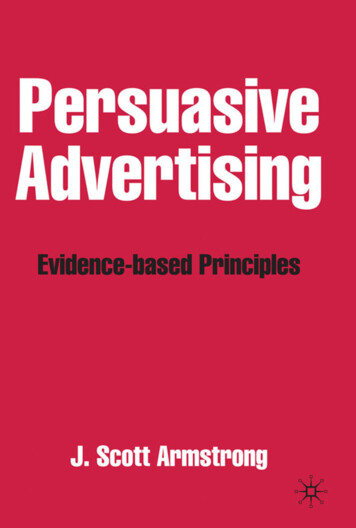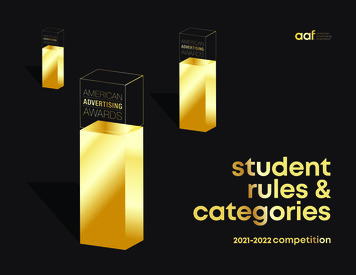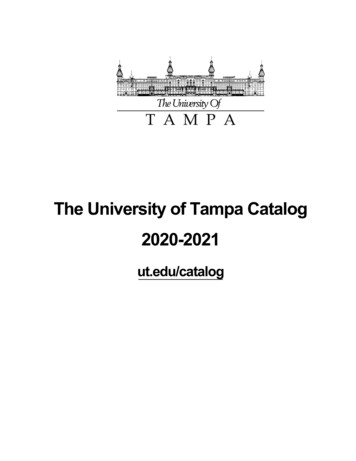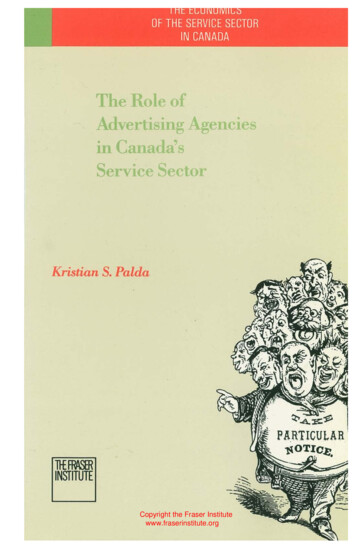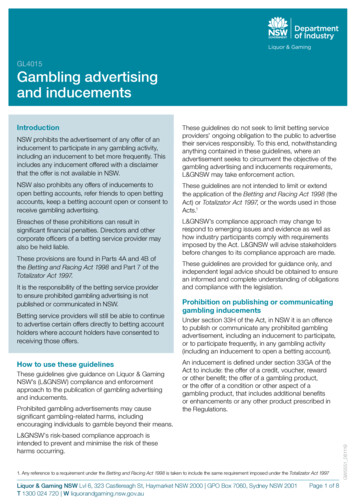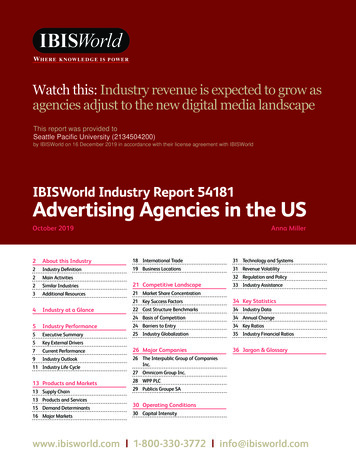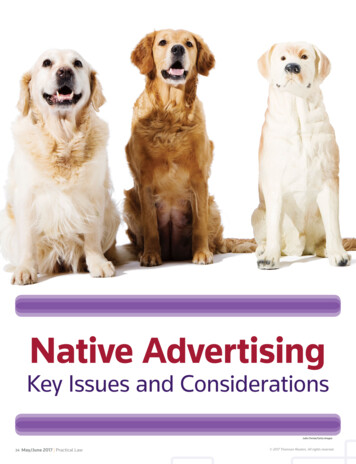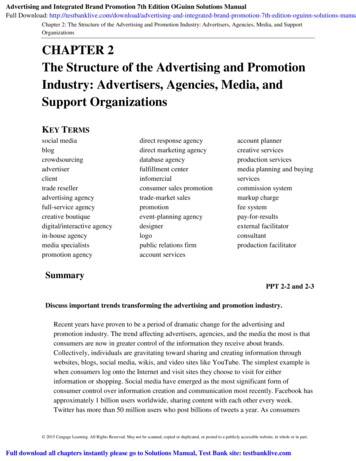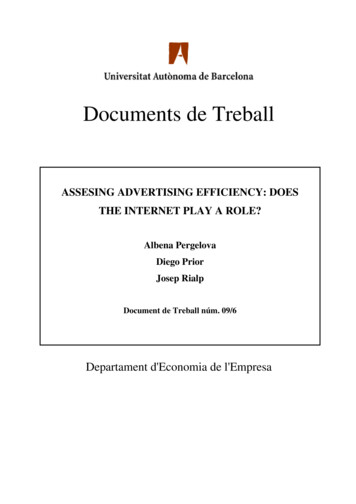
Transcription
Documents de TreballASSESING ADVERTISING EFFICIENCY: DOESTHE INTERNET PLAY A ROLE?Albena PergelovaDiego PriorJosep RialpDocument de Treball núm. 09/6Departament d'Economia de l'Empresa
Albena Pergelova, Diego Prior, Josep Rialp.Coordinador / Coordinator Documents de treball:David e-mail: david.urbano@uab.esTelèfon / Phone: 34 93 5814298Fax: 34 93 5812555Edita / Publisher:Departament d'Economia de /Universitat Autònoma de BarcelonaFacultat de Ciències Econòmiques i EmpresarialsEdifici B08193 Bellaterra (Cerdanyola del Vallès), SpainTel. 93 5811209Fax 93 5812555ISSN:1988-7736. Documents de Treball (Departament d’Economia de l’Empresa, Universitat Autònoma de Barcelona)
Desembre / December, 2009ASSESING ADVERTISING EFFICIENCY: DOESTHE INTERNET PLAY A ROLE?Albena PergelovaDiego PriorJosep RialpDocument de Treball núm. 09/6La sèrie Documents de treball d'economia de l'empresa presenta els avanços i resultats d'investigacions en curs que han estat presentades i discutides en aquest departament; això no obstant, les opinions són responsabilitat dels autors. El document no pot ser reproduït total ni parcialment sense elconsentiment de l'autor/a o autors/res. Dirigir els comentaris i suggerències directament a l'autor/a oautors/res, a la direcció que apareix a la pàgina següent.A Working Paper in the Documents de treball d'economia de l'empresa series is intended as a meanwhereby a faculty researcher's thoughts and findings may be communicated to interested readers fortheir comments. Nevertheless, the ideas put forwards are responsibility of the author. Accordinglya Working Paper should not be quoted nor the data referred to without the written consent of theauthor. Please, direct your comments and suggestions to the author, which address shows up in thenext page.
ASSESSING ADVERTISING EFFICIENCY: DOES THE INTERNET PLAY AROLE?Albena Pergelova, Assistant Professor of Marketing,Department of Business Economics and Administration,Universitat Autonoma de Barcelona08193 Bellaterra (Cerdanyola del Vallès), Barcelona, SpainTel. 34 93 581 2262Fax 34 93 581 2555Albena.Pergelova@uab.esDiego Prior, Full Professor of Accounting and Management Control,Department of Business Economics and Administration,Universitat Autonoma de Barcelona 08193 Bellaterra (Cerdanyola del Vallès),Barcelona, Spain and IESEG School of Management.Tel. 34 93 581 1539Fax 34 93 581 2555Diego.Prior@uab.esJosep Rialp, Associate Professor of Marketing,Department of Business Economics and Administration,Universitat Autonoma de Barcelona08193 Bellaterra (Cerdanyola del Vallès), Barcelona, SpainTel. 34 93 581 2266Fax 34 93 581 2555Josep.Rialp@uab.es
Albena Pergelova (M.S., Universitat Autonoma de Barcelona), Assistant Professor ofMarketing, Department of Business Economics and Administration, UniversitatAutonoma de Barcelona, Albena.Pergelova@uab.esDiego Prior (Ph.D., Universitat Autonoma de Barcelona), Full Professor of Accountingand Management Control, Department of Business Economics and Administration,Universitat Autonoma de Barcelona and IESEG School of Management,Diego.Prior@uab.esJosep Rialp (Ph.D., Universitat Autonoma de Barcelona), Associate Professor ofMarketing, Department of Business Economics and Administration, UniversitatAutonoma de Barcelona, Josep.Rialp@uab.esAcknowledgementThe authors gratefully acknowledge financial support from the Commissioner forResearch and Universities of the Departament d’Innovaciò, Universitat i Empresa de laGeneralitat de Catalunya and the European Social Fund, as well as the SpanishMinistry of Science and Education (projects: SEJ2007-60995/ECON and SEJ200767895-C04-02).
ASSESSING ADVERTISING EFFICIENCY: DOES THE INTERNET PLAY AROLE?ABSTRACTThis research focuses on a major concern for marketers addressing the claims ofinefficiency of the spending on advertising. We examine whether the Internet can helpincrease overall advertising efficiency. Using a sample from the Spanish automobileindustry, we combine a nonparametric method - Data Envelopment Analysis - withrecent important insights from statistics and econometrics studies, and we find thatonline advertising improves the efficiency levels and this effect is more pronounced inthe long-term temporal framework.1
During the last few decades, expenditures in manufacturing and general managementhave been declining while marketing costs have risen (Sheth and Sisodia 1995). From a“budgetary” context perspective, the biggest part of marketing expenditures usually goesto advertising and promotion (Ambler 2000). Some empirical evidence suggests that, inthe long-term, advertising has a positive effect on differentiation and brand equity, whilethis is not the case for promotion (Boulding et al. 1994; Jedidi et al. 1999). Althoughrecent studies have found that promotion has a role in building brand knowledge (e.g.,Palazón-Vidal and Delgado-Ballester 2005), the “traditional wisdom” of advertisingenhancing brand equity has given rise to very high amounts of advertising budgets.However, researchers claim that advertising is “rife with productivity problems” (Shethand Sisodia 1995, p. 19). Consequently, advertising is under increasingly severe scrutinybecause of the growing emphasis on accountability of advertising results (Bhargava etal. 1994).The pressure to justify advertising expenditures has led marketers to look for anew advertising mix, stressing Internet usage. Online advertising is believed to be highlycost-effective relative to other media, particularly when taking into account its ability formore precise targeting and two-way dialogue with customers (e.g., Briggs and Hollis1997). At the beginning of 2006, marketing chief officers of Fortune 500 companiesannounced that they planned to increase online advertising spending up to 32%compared to the previous year. Could this be part of the way of making advertising moreefficient?Academic research in Internet advertising has grown exponentially in the lastdecade in search of the role of the Internet as a marketing tool. Researchers refer toInternet’s capability of addressing individual customers (Deighton 1997), its interactivityand ability to store vast amounts of information (Peterson et al. 1997) and the fact that it2
allows customers to seek unique solutions to their needs (Sheth et al. 2000). Moreover,Internet advertising attracts attention because of the current shift in advertising strategyin favor of deriving maximum response from selected target groups instead of maximumexposure to many unknown audience groups (Yoon and Kim 2001, p. 53). Theaccountability of online advertising along with its contribution to marketing efficiencyand effectiveness are expected to lead to further growth in Web-based advertising efforts(Brackett and Carr 2001; Sharma and Sheth 2004; Hollis 2005).In spite of the expanding attention to the role of the Internet in advertising, thecontribution of online advertising to overall advertising efficiency still remains unclearbecause of a lack of studies that deal with this issue. This study, therefore, aims toaddress this gap in the literature and assess the advertising efficiency with a focus on therole of the Internet. We verify whether the use of the Internet as an advertising toolaffects the overall advertising efficiency in the Spanish automobile industry over aperiod of seven years. The research approach used in this study encompasses twodimensions – competition and time - as crucial in the assessment of advertisingefficiency. Data Envelopment Analysis (DEA) has been chosen as the appropriatetechnique for measuring advertising efficiency because it can deal with the concern inthe marketing literature that advertising expenditure decisions are often made withcompetitors in mind (Rust et al. 2004a). Therefore, it is important to benchmark theresults of advertising against the best performers in the industry. In this field, recentresearch (Simar and Wilson 1998, 2007) demonstrates that DEA efficiency coefficientsare biased estimations of the true, unknown, efficiency levels, this bias being potentiallyamplified when the number of units included in the sample under analysis is relativelysmall. As this may well be the case in our sample, bootstrapping techniques to correctthe observed bias in the DEA efficiency estimates are applied. Once the bias is adjusted3
in the estimated efficiency scores, following Simar and Wilson (2007), we use thecorrected efficiency scores as a dependent variable in a 7-year truncated regression. Theresults of this study suggest that the Internet has gained its place as a necessary part ofthe advertising mix since firms that had invested consistently in online advertisingachieved long-term gains in efficiency.CONCEPTUAL BACKGROUNDAdvertising EfficiencyEarly research in assessing advertising performance focused on advertising ROI (Dhalla1978), efficiency of advertising spending measured by the advertising cost/sales ratio(Smith and Park 1992), and the effect of advertising on sales measured by econometricmodels (Assmus et al. 1984). However, scholars have been pointing out thatenvironment and competition have to be taken into account when assessing theproductivity of marketing actions (Sheth and Sisodia 2002; Vakratsas and Ambler 1999).Rust et al. (2004a: 86) argue that firm performance is fundamentally affected bycompetition and it changes over time, therefore it is necessary to capture bothdimensions (competition and time) in marketing productivity measurement. We discuss,in turn, the theoretical rationale supporting this view.The competition dimensionAccording to the information processing theory, consumers process informationindependently for different brands and then compare the values across all relevantattributes (Fishbein and Ajzen 1975). Nevertheless, as Teng and Laroche (2007) claim,the information processing theory places a limit on the consumer behavior models todiscover the real marketing phenomenon, since competition has been ignored. Newdevelopments in the field posit that the consumer decision-making process is a4
competitive comparison and it is the result of competition at each stage of ad and brandinformation processing (Laroche et al. 1996; Teng and Laroche 2007). Since theconsideration of competing brands is a central element of brand choice (Guadagni andLittle 1983), and competition has an impact on each consumer’s purchase decisions(Rust et al. 2004b), we contend that competition should be included in the measurementof the effect of advertising on sales.The competition dimension has received relatively little attention in advertisingresearch. Only recently have researchers started to examine the effect of advertising bytaking the competition into consideration (e.g., Vakratsas and Ma 2005; Yoo andMandhachitara 2003). Over the last decade, a few studies have applied DEA methods toevaluate advertising efficiency in competitive settings. Luo and Donthu (2001) assessedthe best advertising practices among the top 100 U.S. advertisers and found that manyleading advertisers have low advertising efficiency (below 20 percent). Färe et al. (2004)estimated the cost efficiency in advertising in the U.S. beer industry and found that theoverall cost efficiency index was low and there was considerable variability in mediamix efficiency among firms and over time. Büschken (2007) revealed eight percentinefficiency of brand advertising spending in the German car market. Luo and Donthu(2005) compared two frontier methodologies – DEA and the Stochastic frontier model to benchmark inefficiency, demonstrating about 20% inefficiency of media spending forthe top 100 U.S. advertisers. Lohtia et al. (2007) used DEA to evaluate banneradvertisements efficiency.We follow the latter stream of research and address the competition dimension byevaluating advertising efficiency relative to competitors. Thus, the competitiondimension in our study is introduced by the use of DEA, a technique that explicitly5
considers the competitors in evaluating the efficiency of advertising by benchmarkingthe performance of each unit under analysis to the “best performers” in the industry.The time dimensionMeasuring the effect of advertising on sales, with attention to the duration of this effect,has been extensively studied. Among the techniques applied are the Koyck model (e.g.,Leone 1995), the VAR model (e.g., Dekimpe and Hassens 1995), and the examination ofcumulative effects of advertising on choice and quantity (Jedidi et al. 1999). Much of theliterature used distributed lag models that capture the relation between advertising flowsand sales flows. Clarke (1976) estimated that the duration interval of advertising variedwidely, but the effect of advertising on sales lasts only months. Conversely, otherauthors claim that the advertising effect on sales carries over for multiple years(Dekimpe and Hassens 1995; Peles 1971) and that advertising affects long-runmarketing productivity by creating knowledge and maintaining acceptance about brands(Cobb-Walgren et al. 1995; Berkowitz et al. 2001; Ehrenberg et al. 2002).A critical part of how advertising influences consumer behavior is explained bymemory since consumers usually do not make brand purchase choices at the time ofadvertising exposure, but rather on the basis of the memory of the advertising messages(Mehta and Purvis 2006). Braun-La Tour and La Tour (2004) explain that theconventional wisdom in advertising was that memory for an ad creates a separatememory trace that decays over time. Failure to remember the ad was considered aconsequence of the inability to find the right cue to access its content (Keller 1987).However, a newer view in this respect (Edell 1993) is that the memory for the adinteracts with other information stored in the memory (other ads, personal experience,word-of-mouth about the brand, etc.). Therefore, the memory for advertising is dynamicin nature (Braun 1999).6
In line with the latest developments in consumer behavior and memory research,advertising efficiency in our study is defined as the efficiency of the expenditures inadvertising made by a company in generating sales relative to its competitors, and weestimate the efficiency over a period of seven years. The advertising efficiencymeasurement model is presented in Figure 1. We adopt the definition of technicalefficiency, i.e., the ability to minimize input use in the production of a given outputvector, or the ability to obtain maximum output from a given input vector (Kumbhakarand Lovell 2000).Place Figure 1 about hereInternet AdvertisingSince the early 1990s Internet advertising has grown exponentially and has occupied aplace as a necessary part of the advertising mix. This is so because the Internet isbelieved to be more effective than traditional media in accomplishing certain advertisingobjectives (Li and Leckenby 2004). As stated by Briggs and Hollis (1997), the Weboffers unique advantages over other media in terms of targeting and direct marketing.Deighton (1997) highlights two critical features of the Internet: addressability (thecommunication is directly addressable to individuals) and responsiveness (thecommunication is alert to the receiver’s response). Thus, the Internet provides a targetedmeans for reaching consumers (Burke 1997).The most frequently highlighted feature of Internet advertising is its interactivity(e.g., Rodgers and Thorson 2000). Interactivity is considered one of the main reasonsthat make the Internet a substantial advertising vehicle (Roberts and Ko 2001). Althoughdifferent definitions of interactivity have been provided in the literature (e.g., Steuer1992), there is a common view that in an interactive environment the marketing7
communication is changed from a one-way to a two-way process (Stewart and Pavlou2002) where, on the one hand, advertisers have the advantage of identifying customers,differentiating them, and customizing purchasing and post-purchase service (Roberts andKo 2001) and, on the other hand, consumers have more influence on the process byselecting advertising, and choosing whether, when and how to interact (Pavlou andStewart 2000). The described features of the Internet have led several authors (Brackettand Carr 2001; Sharma and Sheth 2004; Hollis 2005) to the expectation of furthergrowth in Web-based advertising efforts, stressing the contribution of the Internet tomarketing efficiency and effectiveness, in view of the shift in advertising strategy infavor of deriving maximum response from selected target groups instead of maximumexposure to many unknown audience groups (Yoon and Kim 2001).Because of its ability to transmit information quickly and inexpensively, theInternet is expected to have a greater impact on marketing communications than on othermarketing elements. Peterson et al. (1997) suggest that communication channelintermediaries will probably be the most affected by the Internet, since it has beendesigned to deliver information efficiently and is more flexible and superior in targetingbuyers, enabling direct interaction. In a similar vein, Zeng and Reinartz (2003) arguethat the Internet has a very differentiated impact along the three different stages of theconsumer decision-making process: i) search, ii) evaluate and iii) transact. The Internethas been very successful, the authors state, in increasing the efficiency and effectivenessof the first stage – the information search. For different industries and products, thepossible gains from the Internet at the three stages would vary greatly. Products likebooks, travel and computer equipment can provide customer values at all three stages,whereas, for new cars, the Internet currently has its highest potential in the first stage,thus increasing the communication benefits for consumers.8
Indeed, Sheth et al. (2000) point out that in 1999 around 40 percent ofautomobile buyers perused the Internet before visiting a dealer, which is 25 percent morethan in 1998. Yoon and Kim (2001) found that the Internet affected the purchasedecision of customers that are highly involved with automobiles more than other media.Klein and Ford (2003) found that an increasingly greater proportion over time ofsearching for automobiles is conducted using Internet sources. Ratchford et al. (2003)study the effect of the Internet on information search for automobiles and report gainsfor consumers stemming from time savings but also from better buys (reductions inopportunity losses). They further state that the Internet reduces time spent with the cardealer/manufacturer and thus leads to efficiency gains both for the consumer and for thedealer.Another line of research compares the effects and effectiveness of the Internetwith those of other media, with substantial differences among the media not being found(Faber et al. 2004). Comparing online and print advertising, Gallagher et al. (2001)found that those two media are equally effective, given an equal opportunity forexposure to the target audience. The advantage of the Internet is, therefore, in its costeffectiveness. Research has reported that the Internet can boost brand impact at a 60%less cost than offline ads (McCarthy 2003, cited in Kanso and Nelson 2004). Taking anefficiency perspective, if online advertising is equally effective, is better at targetinginterested consumers and is less costly, we expect that:H1: Investing in Internet advertising will increase overall advertising efficiency.The latest developments in Internet advertising suggest that it maximizes itsimpact when combined with conventional advertising. Li and Leckenby (2004) suggestthat the integration of traditional and new media is nowadays essential for many9
advertising campaigns. Parker and Plank (2000) explain that people do not abandontraditional forms of media for the Internet in their search processes. Besides, people areusually exposed first to offline ads, and consumers can be biased towards the Webefforts of advertisers based on previous attitudes toward the brand formed duringexposure on offline advertisements (Balabanis and Reynolds 2001).Researchers have long suggested that multiple-source messages would be moreeasily processed by (and will motivate more) consumers than repetitive messages (e.g.,Edell and Keller 1999; Chang and Thorson 2004; Harkins and Petty 1981a, 1981b,1987). A greater number of sources affects message credibility and this, in turn,influences purchase intention. Chang and Thorson (2004) advocate that marketersshould apply multiple-source strategy since presenting information in varied contextsleads to ad messages being encoded in a slightly different way, which enhances retrievalability and therefore increases awareness. In their study of multiple-source strategies, thetelevision-Web ad mix led to higher attention, higher perceived message credibility, anda greater number of total and positive thoughts, and this effect was superior to therepetitive ad condition. Likewise, Tsao and Sibley (2004) found that there werereinforcing effects between online ads and several offline ad channels, such astelevision, billboards and direct mail, which led them to conclude that the Internet serveda complementary and not a displacement role in the advertising mix.Similarly, Saeed et al. (2003) found evidence about the complementary effect ofWeb site value and offline advertising. In their study, performance was influenced byadvertising expenditures complemented by Web site features facilitating product search,product choice and the product-ownership experience. Ilfeld and Winer (2002) foundthat both online and offline advertising increase Web traffic and this, in turn, increasesbrand equity. Therefore we expect that:10
H2: Companies that employ an advertising mix in which conventional media arecomplemented by Internet advertising will have greater advertising efficiency.A great deal of the research in online advertising has focused on brand-related responsemeasures. This is not surprising since much of the marketing communications efforts ofthe companies are oriented towards building a favorable attitude, brand familiarity andbrand preference in consumers’ minds as a basis for purchase intention and decision.Ehrenberg et al. (2002) view advertising as having the function of brand maintenance orrefreshing acceptance of the brand. They further explain that, since advertising worksthrough people’s memory, the gap between exposure and behavior will be different fordifferent types of products; it could be seconds for an in-store display, months for aninstant coffee, or years for car or insurance campaigns (p. 9). Berkowitz et al. (2001, p.29) suggest that in the case of advertising for brand building, its effect on sales could beseen in the long-term, especially when buying products after evaluation and discussionwith others (which is normally the case when buying automobiles).Similarly, in the online environment, brand-building and brand-supportingactivities are not usually expected to produce quick results. Ilfeld and Winer (2002)found that neither online nor offline advertising lead to immediate development of brandequity, therefore, brand equity for Web sites should be built over time. Drèze andHussherr (2003) found that banner ads have a positive effect even beyond the traditionalclick-through measure, impacting recall, brand recognition and brand awareness;Goldsmith and Lafferty (2002) also supported the positive effect of online advertising onbrand recall and consumers’ view of the brand, and Briggs and Hollis (1997) providedevidence about the sizable effect of banner ads on brand loyalty and attitudes. Hence,desired outcomes such as brand awareness, positive attitude and purchase intention will11
likely be observed after investing consistently in Internet advertising over time. Thus, weexpect that:H3: The more temporal-consistent the firm is investing in Internet advertising,the better its overall advertising efficiency.METHODTo test the effect of Internet advertising on the efficiency of the advertising mix, wefollowed a two-stage research approach. In the first stage, efficiency coefficients perfirm and year using the DEA technique were calculated. The second stage uses the DEAestimates as a dependent variable in a bootstrap truncated regression analysis. A detailedexplanation of the method follows.First Stage: Data Envelopment AnalysisData Envelopment Analysis has become an important tool in efficiency measurement inthe last two decades. It is based on the seminal work of Farrell (1957) and was originallydeveloped by Charnes et al. (1978), with constant returns to scale, and later extended byBanker et al. (1984) to include variable returns to scale. DEA is a non-parametric, linearprogramming based technique designed to measure the relative performance of decisionmaking units (DMUs) where the presence of multiple inputs and outputs posesdifficulties for comparisons. DEA uses the ratio of weighted inputs and outputs toproduce a single measure of productivity (relative efficiency). Efficient DMUs are thosefor which no other DMU generates as much or more of every output (with a given levelof inputs) or uses as little or less of each input (with a given level of outputs). Theefficiency of each unit, therefore, is measured in comparison to all other units. Animportant feature of DEA is that it builds an efficient frontier comprising all of theefficient units, thus allowing a comparison to the best performers (Charnes et al. 1978).12
The efficient DMUs have an efficiency score of one (or 100%), while the inefficientones have efficiency score more than one (or more than 100%) in the output-orientedDEA model, and less than one but greater than zero in an input-oriented model. Aninput-oriented model will look for efficiency by proportionately reducing inputs, whilean output-oriented model will focus on increasing outputs given the observed inputsconsumption. In the case of measuring advertising efficiency, the output-oriented modelseems to be preferable since advertising budgets are usually preliminarily decided andthe goal is maximization of outputs with the available budget (Low and Mohr 1999;Piercy 1987). The DEA models employed in our study are, therefore, output-orientedand with variable returns to scale in order to control for possible different economies ofscale at which companies operate. The model is presented below.Max.β t ,s.t.:K λk yikt β t yito ,i 1,., I , x jkt x ojt ,j 1,., J ,k 1[1]K λkk 1K λk 1,k 1λk 0.Where βt is the efficiency coefficient for the unit under analysis in period t (βt 1indicates that the DMU under analysis is efficient, and βt 1 that this DMU isinefficient. βt-1 determines the output growth rate required to reach the frontier), yito isthe observed outputs vector of the DMU under analysis in period t, x ojt is the observedinputs vector of the DMU under analysis in period t, yikt and x jkt refer to outputs andinputs vectors for the k (k 1, , K) DMUs forming the total sample, and λ stands forthe activity vector.13
The ‘true’ production frontier and the efficiency measure are all unknown.Estimates of the efficiency can be calculated using observed, or actual, input-outputcombinations. These estimates will yield information on the input-output pairs that areconsidered efficient given the observed data. Although this information may appear tobe deterministic, past studies have examined the statistical properties of the DEAestimators. Banker (1993) proved weak consistency of the DEA estimator for the singleinput, single-output case. Gijbels et al. (1999) derived the asymptotic samplingdistribution for the single-input, single-output model along with the asymptotic bias andvariance. However, in the multi-input, multi-output case which typifies our study, thebootstrap seems to be the only way to investigate the sampling distribution of the DEAestimators (Simar and Wilson 2000a).The “smoothed” bootstrap approach of Simar and Wilson (1998) is used here,and the theoretical underpinnings can be found in the extensive work by Simar andWilson (1998, 1999, 2000a,b). The key assumption behind this approach is that theknown bootstrap distribution will mimic the original unknown distribution if the knowndata generating process (DGP) is a consistent estimator of the unknown DGP. Thebootstrap process will, therefore, generate values that mimic the distributions whichwould be generated from the unobserved and unknown DGP (Simar and Wilson 1998,2000a,b). Because DEA estimates a production frontier boundary, generating bootstrapsamples is not straightforward. The “smoothed” bootstrap is based on the DEAestimators themselves by drawing with replacement from the original estimates of beta,and then it applies the reflection method proposed by Silverman (1986).The seven steps in this procedure are quite simple to implement:1.Solve program (1) and obtain the original efficiency scores β1 βk.2.Define a sample βB1 βBk generated from β1 .β K .3.Smooth the sample.14
4.Obtain the final value β1* .β K* by adjusting the smoothed sample so that thevariance of the final bootstrap sequence is asymptotically correct.5.Adjust the original outputs using the ratios β1 β1* . β K β K* .6.*Resolve model (1) using the adjusted outputs to obtain βˆb1* .βˆbK.7.Repeat Steps 2 to 6 B times to obtain B sets of estimates (usually 2000).Once the desired number of samples is obtained, the bias of the original estimatesβ1 .β K is calculated as follows:B ( βˆbias βˆk b 1*bk βk)[2]Bwhich, finally provides the bias-corrected estimator of the true value of β1 .β K :βˆk* β k bias βˆk[3]Second Stage: Truncated Regression AnalysisTo assess the effect of Internet advertising on efficiency we used the biascorrected efficiency coefficient result
Albena.Pergelova@uab.es Diego Prior, Full Professor of Accounting and Management Control, Department of Business Economics and Administration, Universitat Autonoma de Barcelona 08193 Bellaterra (Cerdanyola del Vallès), Barcelona, Spain and IESEG School of Management. Tel. 34 93 581 1539 Fax 34 93 581 2555 Diego.Prior@uab.es


